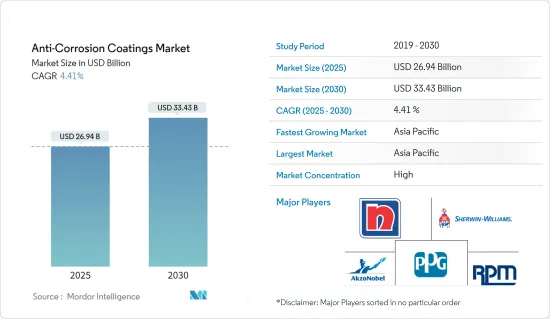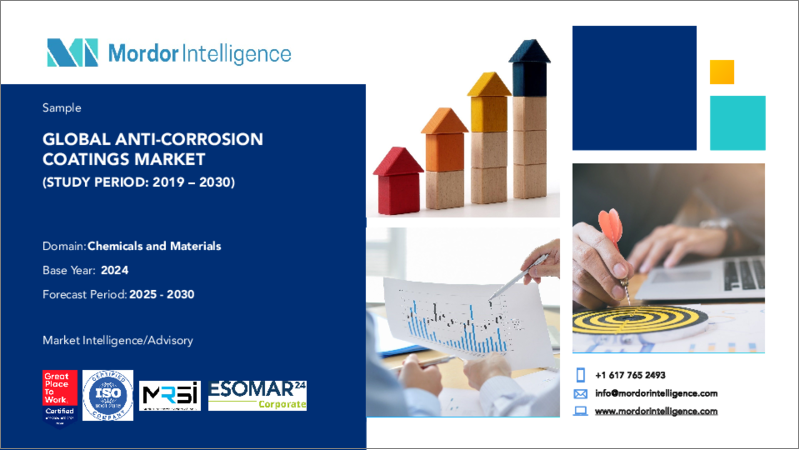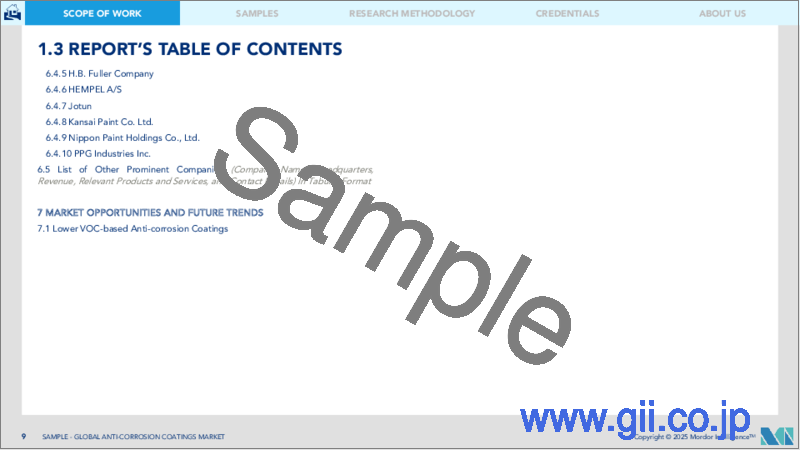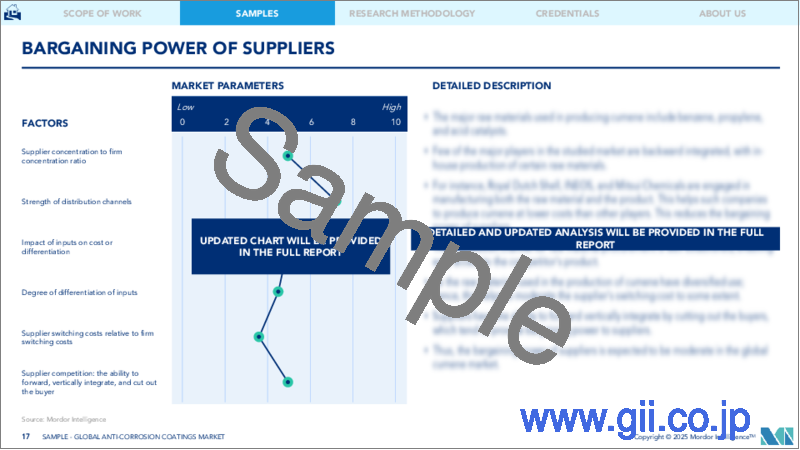|
|
市場調査レポート
商品コード
1640404
防錆コーティング:市場シェア分析、産業動向と統計、成長予測(2025~2030年)Anti-Corrosion Coatings - Market Share Analysis, Industry Trends & Statistics, Growth Forecasts (2025 - 2030) |
||||||
カスタマイズ可能
適宜更新あり
|
|||||||
| 防錆コーティング:市場シェア分析、産業動向と統計、成長予測(2025~2030年) |
|
出版日: 2025年01月05日
発行: Mordor Intelligence
ページ情報: 英文 120 Pages
納期: 2~3営業日
|
全表示
- 概要
- 目次
概要
防錆コーティング市場規模は2025年に269億4,000万米ドルと推定され、予測期間(2025~2030年)のCAGRは4.41%で、2030年には334億3,000万米ドルに達すると予測されます。

主要ハイライト
- COVID-19の大流行は防錆コーティングセグメントに悪影響を与えました。世界の封鎖と政府による厳しい規則により、ほとんどの生産拠点が閉鎖され、壊滅的な打撃を受けました。それにもかかわらず、2021年以降事業は回復しており、今後数年間で大幅に上昇すると予想されています。
- 市場を牽引する主要要因は、インフラ産業の著しい成長、海洋産業からの需要の増加、アジア太平洋と北米における石油・ガス活動の拡大です。
- 揮発性有機化合物(VOC)に関連する規制は、調査された市場の成長を妨げると予想されます。
- 新興国におけるインフラ産業への大規模な投資と水性コーティングの採用拡大が、防錆コーティング市場に今後顕著な成長機会をもたらすと予想されます。
- アジア太平洋は、予測期間中に同地域の様々なエンドユーザー産業への投資が増加するため、防錆コーティング市場を独占すると予想されます。
防錆コーティング市場の動向
インフラ産業からの需要の増加
- インフラセグメントが市場の最大シェアを占めており、最も急成長しているセグメントと推定されます。鉄道、橋梁、道路がインフラの主要セグメントとして貢献しています。人口の急増とインフラプロジェクトの増加が防錆コーティングの需要を押し上げると予想されます。
- アジア太平洋と北米には様々な小規模プロジェクトが広がっています。中国は世界で最も人口の多い国であるだけでなく、鉄道利用者数も最も多いです。
- さらに、アジア太平洋の道路プロジェクトも防錆コーティングの消費を増やすと予想されています。例えば、道路交通・高速道路省によると、現在進行中のバラットマラ・パリョジナでは、貨物輸送の大部分を道路で行うため、全長約2万6,000kmの経済回廊の開発が進められています。経済回廊、GQ、NS-EW回廊の整備は、8,000kmのインター回廊と7,500kmのフィーダー・ルートの建設によって行われています。
- インフラ開発については、中国ブリーフィングによると、2021年末、中国財政部(MoF)は、余剰流動性が年初の投資に拍車をかけることを期待して、2022年の割当額のうち2,296億米ドルを第1四半期に使用するよう事前に割り当てました。
- 2023年4月、世界銀行のデータによると、インフラへの民間参加(PPI)は約917億米ドル、263のプロジェクトに達し、2021年から23%増加しました。中低所得国では、2022年にインフラ投資が回復したことが確認されています。
- 米国運輸省(USDoT)と連邦道路局(FHWA)によると、2022~2030年にかけて、約1,200億米ドルが高速道路と橋梁に割り当てられ、そのうち約2,800の橋梁がすでに着手されています。USDOTは、RAISE(Rebuilding American Infrastructure with Sustainability and Equity)補助金で、166のプロジェクトに22億米ドルを投資しました。これにより、鉄道、港湾、道路、橋梁、複合一貫輸送の近代化が促進され、より安価で、より安全で、サステイナブルものとなります。
- 前述の要因により、予測期間中に防錆コーティングの需要が増加すると予想されます。
市場を独占するアジア太平洋
- アジア太平洋では、中国、日本、韓国が造船産業をリードしているが、ベトナム、インド、フィリピンに新たな海運ハブが出現しています。
- オーストラリアとニュージーランドはともに島国であり、オーストラリアの海岸線と水路の地理的規模から、レジャー用、商業用、防衛用の船舶が数多く建造されています。
- 中国は世界有数の原油輸出入国です。このため、石油・ガス部門に関連する拡大活動に影響を与える変化があれば、中国の防錆コーティング市場に大きな影響を与える可能性が高いです。
- 米国エネルギー情報局によると、中国は2022年、2030年と2060年の気候目標である炭素排出量のピークとカーボンニュートラルをそれぞれ達成するため、低炭素とカーボンニュートラルの取り組みを優先しました。同計画では、天然ガスの年間生産量を8兆1,000億立方フィート(Tcf)に、発電設備容量を3.0テラワット(TW)に増加させる目標を掲げています。
- 防錆コーティングはインフラ用途や世界開発でも重要な役割を担っており、インフラ投資の増加が防錆コーティングの需要を押し上げています。アジア開発銀行(ADB)によると、アジア太平洋が成長の勢いを維持し、気候変動に対応し、貧困をなくすためには、2030年までに年間1兆7,000億米ドルをインフラ開発に投資しなければならないです。
- したがって、上記の要因が予測期間中の防錆コーティング市場を牽引すると予想されます。
防錆コーティング産業概要
防錆コーティング市場は統合されており、主要企業にはPPG Industries, Inc.、Akzo Nobel N.V.、Nippon Paint Holdings、RPM International Inc.、Sherwin-Williams Companyなどがあります。
その他の特典
- エクセル形式の市場予測(ME)シート
- 3ヶ月間のアナリストサポート
目次
第1章 イントロダクション
- 調査の成果
- 調査の前提
- 調査範囲
第2章 調査手法
第3章 エグゼクティブサマリー
第4章 市場力学
- 促進要因
- インフラ産業の著しい成長
- 海洋産業からの需要増加
- アジア太平洋と北米における石油・ガス活動の拡大
- 抑制要因
- 揮発性有機化合物(VOC)関連の政府規制
- その他の抑制要因
- 産業バリューチェーン分析
- ポーターのファイブフォース分析
- 供給企業の交渉力
- 消費者の交渉力
- 新規参入業者の脅威
- 代替品の脅威
- 競合の程度
第5章 市場セグメンテーション(金額ベース市場規模)
- 樹脂タイプ別
- エポキシ
- アルキド
- ポリエステル
- ポリウレタン
- ビニルエステル
- その他
- 技術別
- 水性
- 溶剤型
- 粉末
- UV硬化型
- エンドユーザー産業別
- 石油・ガス
- 海洋
- 電力
- インフラ
- 産業
- 航空宇宙・防衛
- 運輸
- その他
- 地域
- アジア太平洋
- 中国
- インド
- 日本
- 韓国
- その他のアジア太平洋
- 北米
- 米国
- カナダ
- メキシコ
- 欧州
- ドイツ
- 英国
- イタリア
- フランス
- その他の欧州
- 南米
- ブラジル
- アルゼンチン
- その他の南米
- 中東・アフリカ
- サウジアラビア
- 南アフリカ
- その他の中東・アフリカ
- アジア太平洋
第6章 競合情勢
- M&A、合弁事業、提携、協定
- 市場シェア分析**/ランキング分析
- 主要企業の戦略
- 企業プロファイル
- Akzo Nobel N.V.
- Axalta Coating Systems, LLC
- BASF SE
- H.B. Fuller Company
- Hempel A/S
- Jotun
- Kansai Paint Co.,Ltd
- Nippon Paint Holdings Co., Ltd.
- PPG Industries, Inc.
- RPM International Inc.
- Sika AG
- The Sherwin-Williams Company
第7章 市場機会と今後の動向
- 新興国におけるインフラ産業への大規模投資
- 水性コーティングの採用増加
目次
Product Code: 52574
The Anti-Corrosion Coatings Market size is estimated at USD 26.94 billion in 2025, and is expected to reach USD 33.43 billion by 2030, at a CAGR of 4.41% during the forecast period (2025-2030).

Key Highlights
- The COVID-19 pandemic had a negative impact on the anti-corrosion coatings sector. Global lockdowns and severe rules enforced by governments resulted in a catastrophic setback as most production hubs were shut down. Nonetheless, the business has been recovering since 2021 and is expected to rise significantly in the coming years.
- Major factors driving the market are significant growth in the infrastructure industry, an increase in demand from the marine industry, and expansion of oil and gas activities in Asia-Pacific and North America.
- Regulations related to volatile organic compounds (VOCs) and is expected to hinder the growth of the market studied.
- Significant investments in the infrastructure industry in emerging economies and increased adoption of water-borne coatings are expected to provide remarkable growth opportunities in the anti-corrosion coatings market in the future.
- Asia-Pacific region is expected to dominate the anti-corrosion coatings markets due to the increase in investments in various end-user industries in the region during the forecast period.
Anti-Corrosion Coatings Market Trends
Increasing Demand from the Infrastructure Industry
- The infrastructure segment accounts for the largest share of the market and is also estimated to be the fastest-growing segment. Rails, bridges, and roads contributed as the major segments of the infrastructure. The rapid increase in population and growth in infrastructure projects are expected to boost the demand for anti-corrosion coatings.
- There are various small-scale projects spread across Asia-Pacific and North America. Apart from being the most populous nation in the world, China also has the largest number of railroad passengers.
- Moreover, road projects in Asia-pacific are also expected to increase the consumption of anti-corrosion coatings. For instance, according to the Ministry of Road Transport and Highways, the ongoing Bharatmala Pariyojna is developing around 26,000 km length of Economic Corridors in order to carry most of the freight traffic on roads. The improvement of Economic Corridors, GQ, and NS-EW Corridoors has been done by building 8.000 km of Inter Corridors and 7,500 km of Feeder Routes.
- For infrastructure development, according to China Briefings, At the end of 2021, China's Ministry of Finance (MoF) pre-allocated USD 229.6 billion of the 2022 quota to be used in the first quarter in the hopes that the extra liquidity would spur investment at the beginning of the year, with higher quotas allocated to provinces and regions with higher capital needs.
- In April 2023, World Bank data stated that private participation in infrastructure (PPI) reached around USD 91.7 billion with around 263 projects, which accounts for 23% growth from 2021. It is observed in low and middle-income countries, the investment in infrastructure has rebounded in 2022.
- According to the US Department of Transportation (USDoT) and Federal Highway Administration (FHWA), in the years 2022 and 2030, around USD 120 billion has been allocated for highways and bridges, of which nearly 2,800 bridges have already been launched. USDOT invested USD 2.2 billion for 166 projects in Rebuilding American Infrastructure with Sustainability and Equity (RAISE) grants. It will facilitate the modernization of rail, ports, roads, bridges, and intermodal transportation to be more affordable, safer, and sustainable.
- The aforementioned factors are expected to increase the demand for anti-corrosion coatings in the forecast period.
Asia-Pacific Region to Dominate the Market
- In Asia-Pacific, though China, Japan, and South Korea lead the shipbuilding industry, new shipping hubs are appearing in Vietnam, India, and the Philippines.
- Australia and New Zealand are both island nations, and the geographical scale of Australia's coastline and waterways has resulted in a large number of recreational, commercial, and defense vessels.
- China is the leading importer and exporter of crude oil in the world. Thus, any changes affecting the expansion activities related to the oil and gas sector are likely to have a significant impact on the anti-corrosion coatings market in China.
- According to US Energy Information Administration, in 2022, China has prioritized low-carbon and carbon-neutral initiatives in order to meet the country's 2030 and 2060 climate targets of peak carbon emissions and carbon neutrality, respectively. The plan has set a goal for natural gas annual production to increase to 8.1 trillion cubic feet (Tcf) and installed generation capacity to increase to 3.0 terawatts (TW).
- Anti-corrosion coatings also play a significant role in infrastructure applications and global development, and an increase in investment in infrastructure is boosting the demand for anti-corrosion coatings. According to the Asian Development Bank (ADB), if Asia- Pacific has to maintain its growth momentum, respond to climate change, and remove poverty, then the region has to invest USD 1.7 trillion per year by 2030 in infrastructure development.
- Thus, the above-mentioned factors are expected to drive the anti-corrosion coatings market in the forecast period.
Anti-Corrosion Coatings Industry Overview
The anti-corrosion coatings market is consolidated and the major companies include PPG Industries, Inc., Akzo Nobel N.V., Nippon Paint Holdings Co., Ltd., RPM International Inc., and the Sherwin-Williams Company.
Additional Benefits:
- The market estimate (ME) sheet in Excel format
- 3 months of analyst support
TABLE OF CONTENTS
1 INTRODUCTION
- 1.1 Study Deliverables
- 1.2 Study Assumptions
- 1.3 Scope of the Study
2 RESEARCH METHODOLOGY
3 EXECUTIVE SUMMARY
4 MARKET DYNAMICS
- 4.1 Drivers
- 4.1.1 Significant Growth in the Infrastructure Industry
- 4.1.2 Increase in Demand from the Marine Industry
- 4.1.3 Expansion of Oil and Gas Activities in Asia-Pacific and North America
- 4.2 Restraints
- 4.2.1 Government Regulations Related to Volatile Organic Compounds (VOCs)
- 4.2.2 Other Restraints
- 4.3 Industry Value Chain Analysis
- 4.4 Porter's Five Forces Analysis
- 4.4.1 Bargaining Power of Suppliers
- 4.4.2 Bargaining Power of Consumers
- 4.4.3 Threat of New Entrants
- 4.4.4 Threat of Substitute Products and Services
- 4.4.5 Degree of Competition
5 MARKET SEGMENTATION (Market Size in Value)
- 5.1 By Resin Type
- 5.1.1 Epoxy
- 5.1.2 Alkyds
- 5.1.3 Polyester
- 5.1.4 Polyurethane
- 5.1.5 Vinyl Ester
- 5.1.6 Other Resin Types
- 5.2 By Technology
- 5.2.1 Water-borne
- 5.2.2 Solvent-borne
- 5.2.3 Powder
- 5.2.4 UV-cured
- 5.3 By End-user Industry
- 5.3.1 Oil and Gas
- 5.3.2 Marine
- 5.3.3 Power
- 5.3.4 Infrastructure
- 5.3.5 Industrial
- 5.3.6 Aerospace and Defense
- 5.3.7 Transportation
- 5.3.8 Other End-user Industries
- 5.4 Geography
- 5.4.1 Asia-Pacific
- 5.4.1.1 China
- 5.4.1.2 India
- 5.4.1.3 Japan
- 5.4.1.4 South Korea
- 5.4.1.5 Rest of Asia-Pacific
- 5.4.2 North America
- 5.4.2.1 United States
- 5.4.2.2 Canada
- 5.4.2.3 Mexico
- 5.4.3 Europe
- 5.4.3.1 Germany
- 5.4.3.2 United Kingdom
- 5.4.3.3 Italy
- 5.4.3.4 France
- 5.4.3.5 Rest of Europe
- 5.4.4 South America
- 5.4.4.1 Brazil
- 5.4.4.2 Argentina
- 5.4.4.3 Rest of South America
- 5.4.5 Middle East & Africa
- 5.4.5.1 Saudi Arabia
- 5.4.5.2 South Africa
- 5.4.5.3 Rest of Middle East & Africa
- 5.4.1 Asia-Pacific
6 COMPETITIVE LANDSCAPE
- 6.1 Mergers and Acquisitions, Joint Ventures, Collaborations, and Agreements
- 6.2 Market Share Analysis**/Ranking Analysis
- 6.3 Strategies Adopted by Leading Players
- 6.4 Company Profiles
- 6.4.1 Akzo Nobel N.V.
- 6.4.2 Axalta Coating Systems, LLC
- 6.4.3 BASF SE
- 6.4.4 H.B. Fuller Company
- 6.4.5 Hempel A/S
- 6.4.6 Jotun
- 6.4.7 Kansai Paint Co.,Ltd
- 6.4.8 Nippon Paint Holdings Co., Ltd.
- 6.4.9 PPG Industries, Inc.
- 6.4.10 RPM International Inc.
- 6.4.11 Sika AG
- 6.4.12 The Sherwin-Williams Company
7 MARKET OPPORTUNITIES AND FUTURE TRENDS
- 7.1 Significant Investments in the Infrastructure Industry in the Emerging Economies
- 7.2 Increased Adoption of Water-borne Coatings





